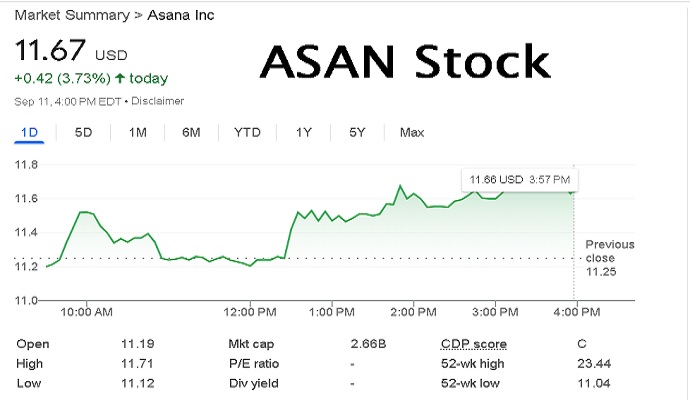ASAN Stock: Asana, Inc. (NYSE: ASAN) Performance

For investors, ASAN stock has attracted attention due to its role in the tech industry and its performance in the stock market. Understanding the financial data, risks, and potential growth of this stock is essential for making informed investment decisions. Asana, Inc. (NYSE: ASAN) is a company that offers work management software aimed at improving team collaboration and efficiency.
Key Takeaways
- ASAN stock represents Asana, a tech company offering software solutions.
- Financials for July 2024 show growth in revenue but ongoing net losses.
- Earnings for July 2024 showed a positive EPS surprise and revenue beat.
- Investors should assess the stock’s risk based on factors like age and risk tolerance.
Financial Overview of ASAN Stock
Asana’s most recent financials give us a clearer picture of the company’s standing in the market. As of July 2024, Asana reported:
- Revenue: $179.21 million, a year-over-year (Y/Y) increase of 10.31%.
- Net Income: A loss of $72.19 million, with a 1.09% improvement compared to the previous year.
- Net Profit Margin: -40.28%, showing a small 8.37% improvement.
- Diluted EPS (Earnings Per Share): Not reported for this quarter.
Despite a growing revenue base, the company is still running at a loss. Investors should evaluate whether Asana can reach profitability as it continues to grow its customer base.
ASAN Stock Earnings Report: July 2024
For the quarter ending in July 2024, Asana’s earnings call revealed some positive results:
- EPS Beat: Asana’s earnings per share beat analyst estimates by 38.57%.
- Revenue Beat: The company also exceeded revenue expectations by 0.87%.
These figures indicate that while Asana is still not profitable, it is performing better than expected in some key areas.
Is ASAN Stock Undervalued
Determining whether ASAN stock (Asana, Inc.) is undervalued involves analyzing various factors, such as the company’s financial performance, market conditions, and valuation metrics compared to its peers. Let’s break down some of these aspects to assess if ASAN stock could be undervalued.
1. Valuation Metrics
One of the most common ways to gauge whether a stock is undervalued is by comparing its current valuation to key metrics such as the Price-to-Earnings (P/E) ratio, Price-to-Sales (P/S) ratio, and other financial indicators.
- P/E Ratio: Since Asana is not yet profitable and has a negative net income, it doesn’t have a traditional P/E ratio. Many high-growth companies in the tech sector may not have a P/E ratio in the early stages because they focus on growth over profitability.
- P/S Ratio: Asana’s P/S ratio can help evaluate its value based on revenue rather than earnings. If the P/S ratio is lower compared to similar software companies, it might suggest that ASAN stock is undervalued.
Comparing these metrics with other companies in the same industry will provide a clearer picture of whether Asana is trading at a lower value.
2. Revenue Growth
Asana’s financial data from July 2024 shows that the company reported $179.21 million in revenue, which is a 10.31% year-over-year growth. This growth rate, while not explosive, indicates that the company is expanding its customer base and generating more sales. However, even with rising revenue, Asana continues to operate at a loss, with a net income of -$72.19 million.
An undervalued stock may have strong revenue growth that isn’t reflected in its stock price. If the market is focusing on the company’s losses without fully appreciating its growth potential, ASAN stock could be seen as undervalued by those who believe the company will eventually reach profitability.
3. Market Sentiment and Investor Expectations
Tech companies like Asana often experience volatility due to market sentiment. If investors are pessimistic about the broader tech sector or the company’s profitability timeline, the stock price may be lower than its potential long-term value. Asana has posted earnings surprises recently, with its July 2024 EPS beating estimates by 38.57%, and a revenue beat of 0.87%, suggesting that the company is performing better than expected.
If market sentiment improves, particularly if Asana continues to beat expectations or shows signs of narrowing its losses, ASAN stock could rise, making current prices seem undervalued.
4. Profitability Concerns
One of the main reasons ASAN stock may not be undervalued is its lack of profitability. With a net profit margin of -40.28%, Asana has significant work to do to become a profitable company. Investors often view profitability as a key indicator of a company’s long-term viability. If Asana struggles to improve its profit margins, the stock could remain under pressure.
However, for long-term investors who believe in the company’s business model and growth potential, Asana’s current losses may be less of a concern if they expect the company to turn profitable in the future.
5. Analyst Opinions and Price Targets
Looking at analyst price targets can provide insight into whether ASAN stock is undervalued. If the current stock price is significantly below the average price target set by analysts, this could indicate that the market is undervaluing the stock. Keep in mind that analysts take into account various factors like revenue growth, profitability, market conditions, and the company’s competitive position when setting these targets.
6. Growth Potential in the Work Management Space
Asana operates in a rapidly growing industry. The work management software market is expected to expand as businesses continue to adapt to remote work and need tools to improve collaboration and productivity. Asana’s ability to capture a significant share of this market could justify a higher valuation in the future.
If you believe that the company is well-positioned to benefit from long-term trends in the tech sector, ASAN stock may be undervalued relative to its future growth potential.
At present, ASAN stock may not be considered traditionally undervalued due to its ongoing losses and negative profit margins. However, investors who focus on long-term growth and believe in the company’s ability to eventually achieve profitability might view the stock as undervalued based on its revenue growth, market position, and potential for earnings improvements.